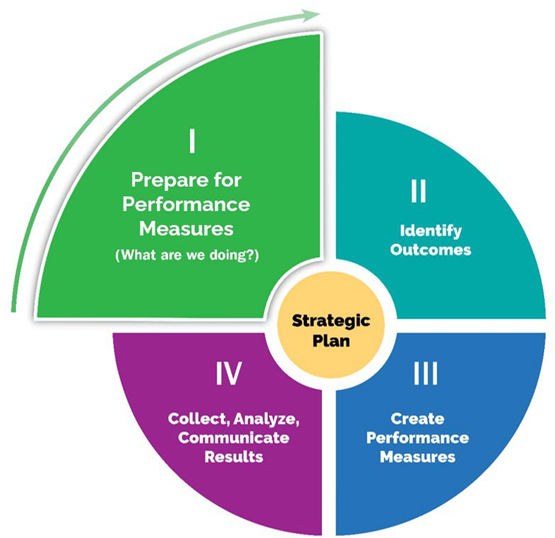Stage I: Prepare for Performance Measures

In this stage, you will learn what you need to do to get a good start on putting a performance measurement framework in place. This means establishing a clear understanding and agreement amongst your team about priorities. To fully understand the priorities, the team will need a clear understanding of the initiative and agreement on the process to reach the desired outcomes.
To prepare you will need to:
- bring the team together
- assess your current plan or strategy
- identify and engage stakeholders
- decide what to measure
Bring the team together
The organization will need a team to help with different stages of the performance measurement process. It should include people who:
- work on the strategy being assessed
- require the results
- are familiar with collecting, storing and analyzing performance data
- are familiar with report writing and/or communicating information
- speak positively of the initiative
- have a good working knowledge of performance measurement
Assign roles and responsibilities and make sure each team member is clear about what is expected of them, including an understanding that this may change over the course of the process.
For example, consider who will be the lead for the following tasks:
- ensuring that the performance measurement data are collected and analyzed
- reviewing and assessing the data
- assembling the information that will be used to write the report on the outcomes
- submitting the report on time to the leader responsible for signing off on the report
Assess your current plan or strategy
As you begin to think about performance measurement within your specific context, it is important to assess the current state of your organization.
Is there a plan or strategy in mind? If so, this is the place to start. It will help you think about performance measurement in a logical way. Chances are the plan lists some desired outcomes or goals and there has been some planning around the activities needed to achieve those outcomes.
1. Identify and engage your stakeholders
Engaging stakeholders is another important aspect of developing a performance measurement framework. The team will need to identify potential stakeholders. Stakeholders could be any person, group or organization that is affected by the organization’s activities or has an interest in or expectation of the work they do.
Internal stakeholders
Internal stakeholders may include the leaders of the organization and board of directors. These stakeholders can also be staff members who may or may not be directly involved in the initiative or the performance measurement process.
It may help to bring internal stakeholders to the table early so that they are informed and can help recruit external stakeholders. It will also help support you if they understand what a performance measurement framework is and the reason your organization is measuring a particular strategy. You need their buy-in, so they need to agree on the desired outcomes, the actions to be taken to get there and the time and resources to be invested.
External stakeholders
External stakeholders may be volunteers, members, donors or others who have an ongoing interest in the organization. There are benefits to bringing external stakeholders into the process. External stakeholders may have valuable insights about the work of the organization.
It is a good idea to engage a variety of stakeholders and their different perspectives. However, if the organization has a long list of stakeholders, identify those who are in the best position to contribute to the discussion. Consider their interests, their influence and their information need and then decide who may best align with this exercise.
Once the stakeholders are on board, take advantage of their knowledge and expertise. Consult them regularly to make sure the organization is on the right path. This will also help maintain their support throughout the process. Their perspectives or participation can help strengthen the design of the performance measurement framework.
2. Decide what to measure
The performance measurement framework can be used to assess the effectiveness of a project, program or initiative (project). Ideally, the goals or desired outcomes of the project will be linked to your organization’s strategic plan.
Reviewing your organization’s strategic plan will help to develop your performance measurement framework, especially the outcomes. If your organization does not have a strategic plan, do not let it stop you from developing a performance measurement framework for individual projects.
Diagnostic questions
The answers to the following questions will help quickly identify and explain to others where you currently are, and what you are proposing for the performance measurement process. If you answer “yes” to all these questions, you are prepared to move on to the next stage.
- If you are creating measures for your strategic plan, have you thoroughly clarified your expectations for performance measurement?
- If you are creating measures for a specific initiative, do you understand the requirements of the performance measurement process?
- Do you have the right resources and team to implement performance measurement?
- Have you identified the internal and external stakeholders for the performance measurement team?
- Have you discussed expectations with them?
- Have you addressed any potential resistance to performance measurement?
A full list of diagnostic questions from all four stages can be found in Appendix 2: diagnostic questions.